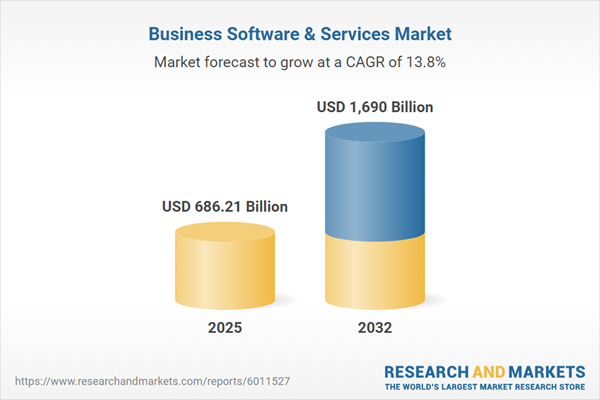Speak directly to the analyst to clarify any post sales queries you may have.
Senior decision-makers in the business software and services market are navigating an industry shaped by rapid digital advancement, shifting compliance requirements, and increasing operational complexity. Staying ahead requires clear insight into evolving technology ecosystems and regulatory mandates.
Business Software & Services Market Snapshot
The business software and services market is characterized by steady progress as companies actively pursue digital transformation to optimize efficiency and performance. Enterprise leaders are increasingly moving to scalable, integrated software platforms that align with shifting operational targets. Digital ecosystems form the bedrock of business continuity, tying technology investments directly to enterprise goals and providing seamless connectivity across departments. Cloud infrastructure has become central to adapting quickly to changing market needs, while advanced analytics support better decision-making and increase responsiveness throughout organizations. Adoption rates, competitive dynamics, and implementation approaches are influenced by regional infrastructure readiness and distinct regulatory landscapes.
Scope & Segmentation: Business Software & Services Market
- Component: Managed services enhance operational reliability and risk control; professional services elevate process improvements and innovation; business software ensures organizational connectivity and collaboration.
- Deployment: Flexible deployment models—private, public, hybrid cloud, and on-premises—allow organizations to tailor security and compliance to specific sector requirements.
- Organization Size: Scalable solutions meet operational demands at every scale, supporting broad enterprise integration as well as targeted, agile applications for mid-sized and smaller businesses focused on compliance and efficiency.
- Application: Solutions, spanning Software-as-a-Service and on-premises deployments, power mission-critical functions in business intelligence, analytics, CRM, ERP, and supply chain management.
- Industry Vertical: Modular and bespoke platforms are designed for financial services, insurance, public sector, healthcare, IT, telecom, manufacturing, and retail, helping address regulatory complexity and supporting operational adaptability.
- Region: Leading regions—including North America, South America, Europe, Middle East and Africa, and Asia-Pacific—advance at varied paces based on infrastructure maturity, policy frameworks, and investment direction.
- Key Companies: Market leaders such as Microsoft, Oracle, SAP, Salesforce, IBM, Adobe, Intuit, VMware, ServiceNow, and Workday are continually enhancing product portfolios in line with changing client expectations and technological trends.
Business Software & Services Market: Key Takeaways for Leaders
- Cloud-native platforms and AI-integrated tools drive automation and adaptability, supporting reliable operations while enabling swift responses to strategic shifts.
- Managed and professional service providers help translate technical infrastructure into stable and dependable results, sharpening risk management and process oversight.
- Low-code and no-code development sites put powerful tools in the hands of non-technical teams, helping organizations accelerate solution deployment and support agility in rapidly shifting environments.
- API-centric designs and microservices architectures streamline integration and feature expansion, reducing the complexity of connecting new components or adapting to changing business requirements.
- Regional deployment strategies benefit from careful consideration of local infrastructure and regulatory maturity, optimizing rollouts while maintaining compliance.
- Industry-specific workflows equip highly regulated sectors to strengthen compliance and maintain operational continuity under evolving market and regulatory scenarios.
Tariff Impact: Evolving U.S. Trade Policy and Strategic Consequences
- Ongoing changes in U.S. tariff policies prompt technology providers to adjust supply chain strategies, focusing on stable access to critical inputs and control of operational expenses.
- Supplier network diversification and alternative sourcing approaches help sustain operations amid shifting trade dynamics.
- Investments in localization and nearshoring initiatives enable organizations to comply with changing policies and minimize disruption within global supply chains.
Methodology & Data Sources
This analysis leverages direct interviews and structured surveys with IT decision-makers. Additional insights come from audited financial records, technical documentation, and region-specific regulatory resources to ensure a comprehensive view of the sector.
Why This Report Matters
- Enables executive teams to proactively respond to regulatory changes and advancing digital technologies that impact compliance strategies and operational resilience.
- Offers actionable guidance for leveraging new technology adoption and navigating policy shifts with targeted risk management and growth-oriented approaches.
- Supports senior leaders in aligning teams on transformation goals, managing risk, and strengthening organizational adaptability in a rapidly changing industry landscape.
Conclusion
This report equips senior decision-makers with in-depth guidance for making informed technology investments, strengthening risk management, and advancing operational resilience in the dynamic business software and services sector.
Additional Product Information:
- Purchase of this report includes 1 year online access with quarterly updates.
- This report can be updated on request. Please contact our Customer Experience team using the Ask a Question widget on our website.
Table of Contents
3. Executive Summary
4. Market Overview
7. Cumulative Impact of Artificial Intelligence 2025
Companies Mentioned
The companies profiled in this Business Software & Services market report include:- Microsoft Corporation
- Oracle Corporation
- SAP SE
- Salesforce, Inc.
- IBM Corporation
- Adobe Inc.
- Intuit Inc.
- VMware, Inc.
- ServiceNow, Inc.
- Workday, Inc.
Table Information
| Report Attribute | Details |
|---|---|
| No. of Pages | 186 |
| Published | October 2025 |
| Forecast Period | 2025 - 2032 |
| Estimated Market Value ( USD | $ 686.21 Billion |
| Forecasted Market Value ( USD | $ 1690 Billion |
| Compound Annual Growth Rate | 13.8% |
| Regions Covered | Global |
| No. of Companies Mentioned | 11 |









